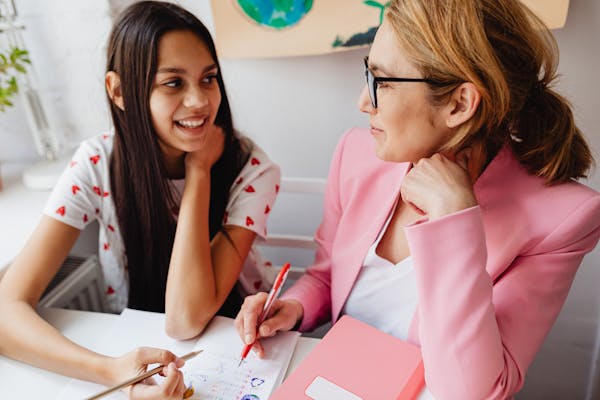Table of Contents
Introduction
Did you know that students who have strong relationships with their teachers do better in school? Research shows that a good student-teacher relationship boosts a student’s engagement and performance. This connection is key for trust, respect, and emotional support.
Imagine a classroom where students feel valued and inspired to learn. That’s what a strong bond between students and teachers can create. These relationships help students not just in school but also in life.
But, building these relationships is hard work. In today’s fast-paced schools, making meaningful connections can be tough.
The student-teacher relationship is crucial for a great classroom. It makes learning meaningful. When students and teachers connect, everyone can do their best. Whether you’re a teacher or a student, understanding how to improve this relationship is key.
In this article, we’ll cover everything about strengthening student-teacher relationships. You’ll learn about their importance, benefits, and challenges. We’ll also share strategies for both students and teachers to build stronger bonds.
By the end, you’ll know how to create a classroom culture of trust, respect, and teamwork. Let’s start!

Understanding the Student-Teacher Relationship
What Is the Student-Teacher Relationship?
The student-teacher relationship is key to learning. It’s not just about sharing knowledge. It’s about creating a bond that makes learning better. This bond is built on trust, communication, respect, and support.
In my classroom, I saw how this bond helps students grow. When students feel safe asking questions, they learn more. A good student-teacher relationship is like a partnership, working together towards goals.
Why Is It Important?
A positive student-teacher relationship is vital. I’ve seen how it helps students succeed. When students trust their teachers, they’re more likely to participate and learn.
Students who feel supported by their teachers do better in school. I helped a student who was afraid of math. By encouraging her, she gained confidence and improved.
Also, a good relationship with teachers helps students emotionally. Students feel safe and supported. This support helps them deal with school stress.
The Current State of Student-Teacher Relationships
In today’s classrooms, the student-teacher relationship is more critical. Teachers face challenges like bigger classes and more work. But, schools that focus on building relationships see great results.
Some students find it hard to connect with teachers due to cultural differences or personal issues. Teachers need to make an effort to understand and connect with these students. I remember a student from a different culture who felt disconnected. By showing interest in his culture, I built a strong relationship with him.
The Importance of Student-Teacher Relationships
Enhancing Academic Performance
A strong student-teacher relationship boosts academic performance. When students trust their teachers, they’re more likely to learn and ask for help. In my classroom, students who trusted me did better in class and showed more interest in learning.
I helped a student who struggled with English literature. Our strong relationship helped him feel confident and improve his grades. This shows how trust can lead to better grades and confidence.
Trust also encourages a growth mindset. Students believe they can improve with effort and perseverance. This mindset is key to overcoming challenges and achieving success.
Promoting Emotional Well-Being
Strong student-teacher relationships are key for students’ emotional well-being. When students feel cared for, they worry less and focus better on learning. I’ve seen how students with strong bonds with me felt more at ease sharing personal issues, helping them succeed.
Such relationships make students feel safe in class, reducing stress. This safety is vital for students to grow resilient and handle school’s ups and downs. For instance, a student facing family problems and struggling in school found support from me. This support helped her do better in school and life.
Shaping Future Interactions
Positive student-teacher relationships impact students’ future. I’ve seen how these relationships shape students’ academic and professional paths. Positive interactions with teachers set a good example for future relationships in college and the workplace.
One of my students, who was once shy, became confident with my support. Now, he’s a successful professional, crediting his high school years with me for his success. A strong bond between a student and teacher can influence both current and future achievements.
Advantages of a Strong Student-Teacher Relationship
Advantages for Students
Positive relationships with teachers offer many benefits for students. Students who feel supported by their teachers tend to do better academically. This success boosts their self-esteem and sense of belonging.
In my class, a shy student became more confident after I connected with him. His grades improved, but more importantly, he gained confidence in himself. This change was due to the trust and support I provided.
Students with strong teacher relationships stay motivated and engaged in their studies. They feel their efforts are valued, encouraging them to keep striving for success.
Advantages for Teachers
Teachers also benefit from strong student-teacher relationships. Building trust leads to better classroom behavior and a more positive learning environment.
When students respect me, managing the classroom is easier. This allowed me to focus more on teaching and engaging with students. It made my job less stressful and more rewarding.
Strong relationships with students also increase job satisfaction. Connecting with students makes teaching more fulfilling. Knowing I’ve positively impacted a student’s life is incredibly rewarding.
Advantages for Schools and Communities
Strong student-teacher relationships benefit schools and communities. Teachers who connect well with students create a more collaborative and inclusive school culture.
Schools that prioritize positive relationships see better academic results and lower dropout rates. These schools foster trust and respect, improving both student performance and the school environment.
Barriers to Building Strong Relationships
Large Class Sizes and Limited Time
Large class sizes can make it hard to connect with students. It’s tough to give each student the attention they need. This can make students feel like just another face in the crowd.
To overcome this, I’ve tried creative ways to connect with students. For example, I’ve broken the class into smaller groups for discussions. I also set aside one-on-one time during office hours to get to know students better.
Cultural and Personal Differences
Cultural differences and personal struggles can also be barriers. It’s important for teachers to be aware of these challenges. I had a student from a different culture who initially struggled to connect with me.
By learning about his culture and interests, I was able to build a stronger bond. This led to improved academic performance. Teachers who listen and show empathy can make a big difference.
Teacher Burnout
Teacher burnout is a major barrier. It’s easy to get overwhelmed by daily tasks and forget about building relationships. I’ve experienced burnout and found it hard to connect with students when I was overwhelmed.
To avoid burnout, I recommend self-care and finding balance. Setting aside time for relaxation and seeking support from colleagues can help. Breaking tasks into manageable chunks also reduces stress and improves relationships with students.
Strategies to Improve Student-Teacher Relationships
Building Trust Through Consistency
Trust is key in any strong relationship. Being consistent in your actions and words is essential. When students know they can rely on you, they respect you more and engage in learning.
In my classroom, I always kept promises and treated students fairly. This consistency built trust. For example, I always met with students who were struggling, providing support without judgment.
Active Listening and Communication
Effective communication is a two-way street. It’s not just about speaking; it’s about listening too. I made sure to listen to my students and understand their concerns.
One strategy was holding regular one-on-one check-ins. These allowed me to address issues and show I cared. This strengthened our relationship.
Personalizing Learning
Every student is unique, and tailoring learning experiences can build a deeper connection. Personalizing lessons can increase engagement and improve performance. For example, I incorporated creative assignments for students interested in art.
I also used learning styles assessments to tailor my teaching. This made the classroom more inclusive and encouraged participation from all students.
Showing Empathy and Understanding
Empathy is a powerful tool in building strong student-teacher relationships. I remember a student facing tough times at home, which affected her schoolwork. Instead of punishing her, I listened and offered support. This small act of empathy helped her open up and improve her grades and emotional health.
Demonstrating empathy means more than just understanding students’ struggles. It’s about encouraging them, showing compassion, and being flexible. Small gestures, like asking about their day or checking in when they seem down, can make a big difference.
Encouraging Student Feedback
Asking for feedback is a great way to improve relationships with students. I regularly asked for their thoughts on the class and what could be better. This made me a better teacher and showed students their opinions mattered.
Using student feedback in lesson plans and activities makes students feel heard and valued. It creates a collaborative environment where everyone works together to improve learning.
The Role of Schools in Supporting Student-Teacher Relationships
Creating a Supportive School Environment
Schools are key in building positive student-teacher relationships. Administrators and staff should focus on relationship-building. This can be done through professional development and policies that support personalized learning and student well-being.
I’ve seen schools where leadership prioritizes relationship-building. The results were clear. Supported teachers connect better with students, leading to a positive school culture and better grades.
Collaboration with Parents and Guardians
Collaborating with parents and guardians is also important. When parents are involved, it creates a sense of support between home and school.
Reaching out to parents early and keeping in touch helps build a strong partnership. Parents who know about their child’s progress and challenges are more likely to support us in the classroom. This benefits the student greatly.
Conclusion
Building strong student-teacher relationships improves learning for everyone. Strategies like fostering trust, personalizing learning, and showing empathy make a big difference. These relationships help students grow both personally and academically.
By focusing on these relationships, we can create classrooms where students feel supported and empowered to succeed.
Frequently Asked Questions
- How do I build trust with my students?
Start by being consistent and fair. Always keep your promises, be there for your students, and listen to their concerns. - What are some ways to connect with students in large classes?
Use group activities, one-on-one check-ins, and personalized learning strategies to connect with students. - Why is empathy important in teaching?
Empathy helps teachers understand students’ challenges, building trust and a supportive learning environment. - How can I get parents involved in their child’s education?
Keep in touch with parents through updates or meetings to discuss challenges. This builds a supportive home-school partnership. - What are the benefits of positive student-teacher relationships?
Positive relationships boost academic performance, emotional well-being, and engagement with learning.






